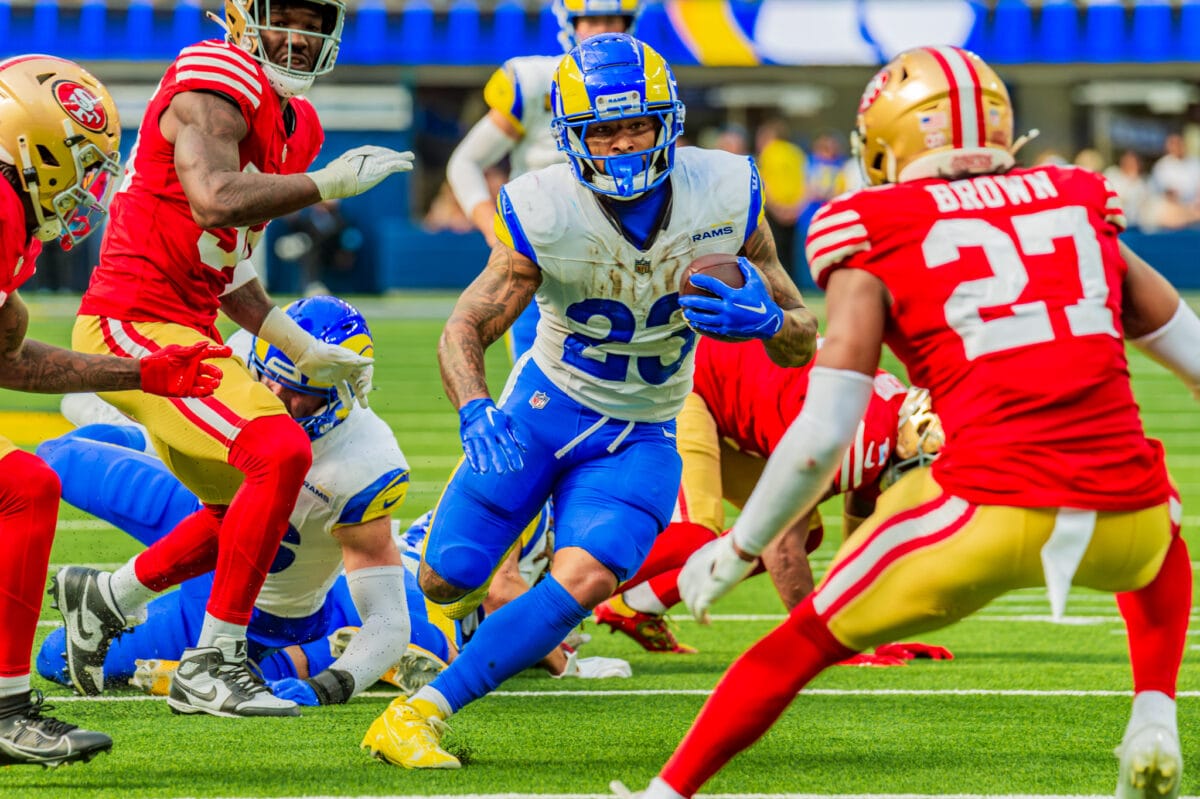
Quick Slant - TNF: These 60 Minutes
Mat Irby’s Quick Slant
Heading east from Ray Muth Park, where you’d detect children laughing, whistles blowing, and the scent of hot dogs and cotton candy on the air, you’d turn right onto Marblehead. On a slow Saturday, traffic would be predictably light; sleepy maples would line the sidewalk before grand white apartments; eventually, a clearing pulled you left on Gloucester, then right over a bridge and into some of Northern Virginia’s biggest sky. Past the glass data centers on the right, a new inflatable practice dome could be seen bubbling over the horizon, white and odd among sparse trees, like a great ping pong ball sliced in half and laid among weeds. After a right on Loudoun, it stretched into something more like a half-deflated blimp, shimmering and endless.
Beyond security and an incessantly flapping burgundy flag, a modest two-story building sat, alone and boring, framed by hollies and hardwoods—something like a cold, industrial corporate headquarters for a Friday’s, or a Chico’s. It was 2012, and a hive had formed within; it was the new coaching staff for two-time Super Bowl champion Mike Shanahan and a team with a long legacy, now tarnished, seeking resurgence.
These were just children, really: Raheem Morris, Matt LaFleur, Mike McDaniel, and Bobby Slowik; alongside star pupils Sean McVay and Kyle Shanahan, the coach's son. Gathered like disciples to the gospel of the wide zone, they learned at the feet of its master, who, along with OC Gary Kubiak and legendary O-line coach Alex Gibbs, had taken a gadgety change-up and transformed it into the foundation for a complete offensive system that won two Super Bowls in Denver in the nineties.
The Washington experiment had its share of successes and failures; RGIII won the OROY award and led an improbable playoff run. As quickly, his knee unraveled beneath his weight while chasing an errant shotgun snap on the muddy grass of FedEx Field, tearing his ACL and LCL and leaving his future rewritten. Griffin was a force that arrived, powerful and sudden, and as quickly came unglued. The shocking turn at this fork in the road led to treacherous thistle; the fragile hopes of the brief Shanahan era in Washington vanished with them. Washington has suffered almost ever since, the shredded ligaments of a leg catalyzing the broken will of a city.
While together, their early successes were modest, but the hive soon split, each colony becoming its own mighty empire.
One such empire took root in St. Louis, with continuing service to Los Angeles: McVay, then the youngest HC in the league, brought an immediate resurgence to the Rams, transforming a struggling franchise that had spent years mired in Jeff Fisher’s conservative, grind-it-out style into a dynamic, modern offense that built off of Shanahan’s core tenets, essentially turning the page from an old NFL to a new one. By 2021, the Rams were champions, and a copycat league scoured for its own pathway into the vanguard.
Another was the younger Shanahan, Kyle, hired by San Francisco in 2017. The Niners still have only the five Lombardis they had when he arrived, but in the Bay Area, contention is now an annual tradition. When people speak of the Shanahan system today, they speak more of Kyle than Mike; his additions are evolution, and football is different now because of him.
Thursday, they meet—big brother and little (I’ll leave it to you which is which)—as they do twice per year. This time, unlike the last few, the NFC West has arguably been the best foursome in the NFL, so the stakes have been raised. The implications of this Thursday cannot be overstated; the season could easily hinge on these 60 minutes.
49ers
Implied Team Total: 19.25
For all the buildup surrounding a game like this, one side is already licking its wounds. On their initial Monday injury report, the 49ers reported 12, including WRs Ricky Pearsall and Jauan Jennings, and QBs Brock Purdy and Mac Jones. File these, along with a trio of the team’s best players, DE Nick Bosa, TE George Kittle, and WR Brandon Aiyuk, who are already on IR. All but Jones have been designated as out, and Jones apparently will play.
Jones has performed well in his two starts so far, finishing as the QB6 and QB14 in Weeks 2 and 3, respectively. He ranks as fantasy’s QB4 in terms of expected points per game (EP/G). It should be noted that one of his starts came against the Saints, who rank 27th in defensive EPA/play.
The Niners are already overachieving according to Pythagorean expectations, with 3.7 wins over expected (WOE, 6th).
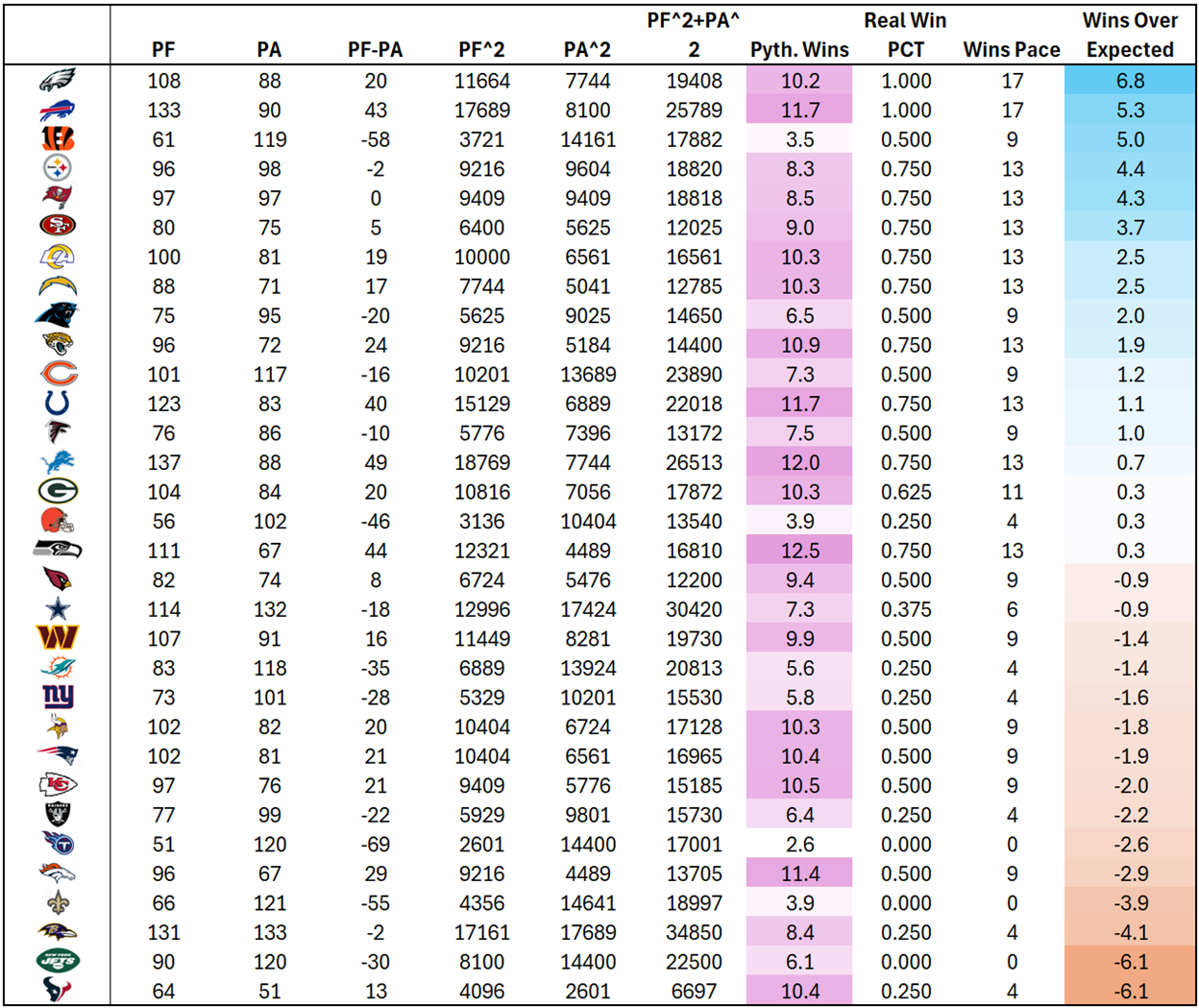
Run rates are a little up this year in general, so the 49ers show up with a -1.07% pass rate over expected (PROE), but they still rank 15th in the league. From a neutral script, San Francisco has thrown at a 57% (T-15th); this is somewhat rare for a Shanahan team. San Francisco has had the third-highest run rate (53%) from a neutral script since 2018.
The 49ers have run the fifth-most total offensive plays (277) through the first four games; this is less unusual. What the Niners usually lack in expediency to the line, they make up for in efficiency, extending drives, driving up play counts, and resulting in more points. This year, their efficiency is depressed, as they rank 19th in offensive EPA/play, and they’ve conversely steadied with a fifth-ranked offensive success rate.
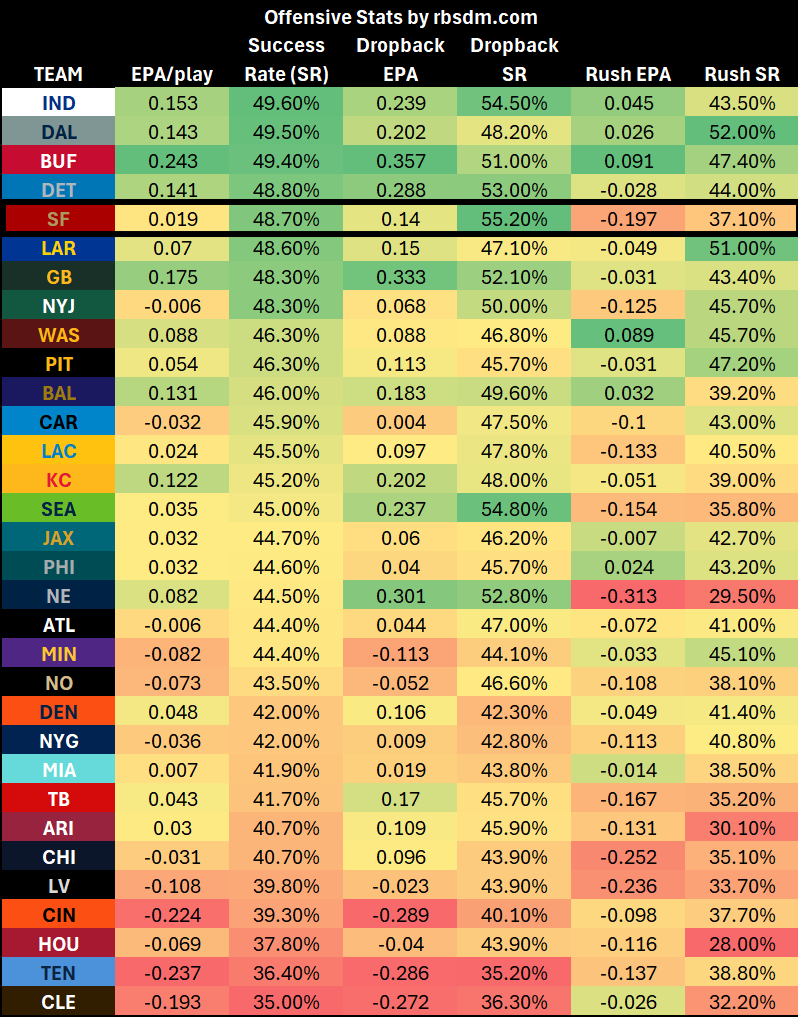
Of course, it is related, but the 49ers rank fifth in offensive yardage (368.0/G /G) and 23rd in offensive scoring (20.0/G). Scoring points raises efficiency, so this makes some sense.
Jones may be an intriguing streamer in superflex or 2QB leagues now that byes have begun, but he can’t be trusted this week in single-QB formats.
The Rams run zone at 74.8% (12th), and single-high at 57.1% (10th). Their most popular alignment, by far, is Cover 3, which they run at a rate of 39.5% (6th).
According to the types and rates of coverage the Rams run, Jones should perform well, agnostic of specific personnel. Fantasy Points’ QB Coverage matchup model gives Jones a +19.2% coverage grade this week (5th), and he is expected to score 0.43 fantasy points per dropback (FP/DB, 13th), a relatively neutral amount. However, we should remember that A, he has none of the Niners’ usual complement of weapons, except for RB Christian McCaffrey, and B, he himself is injured. And in addition to all that, he will be up against a more challenging opponent than he was in Weeks 2 and 3.
The Rams have had a very stout defense, ranking fifth in defensive EPA per play and seventh in defensive success rate. They have been particularly potent against the pass, ranking 2nd in EPA per dropback and eighth in defensive success rate on dropbacks.
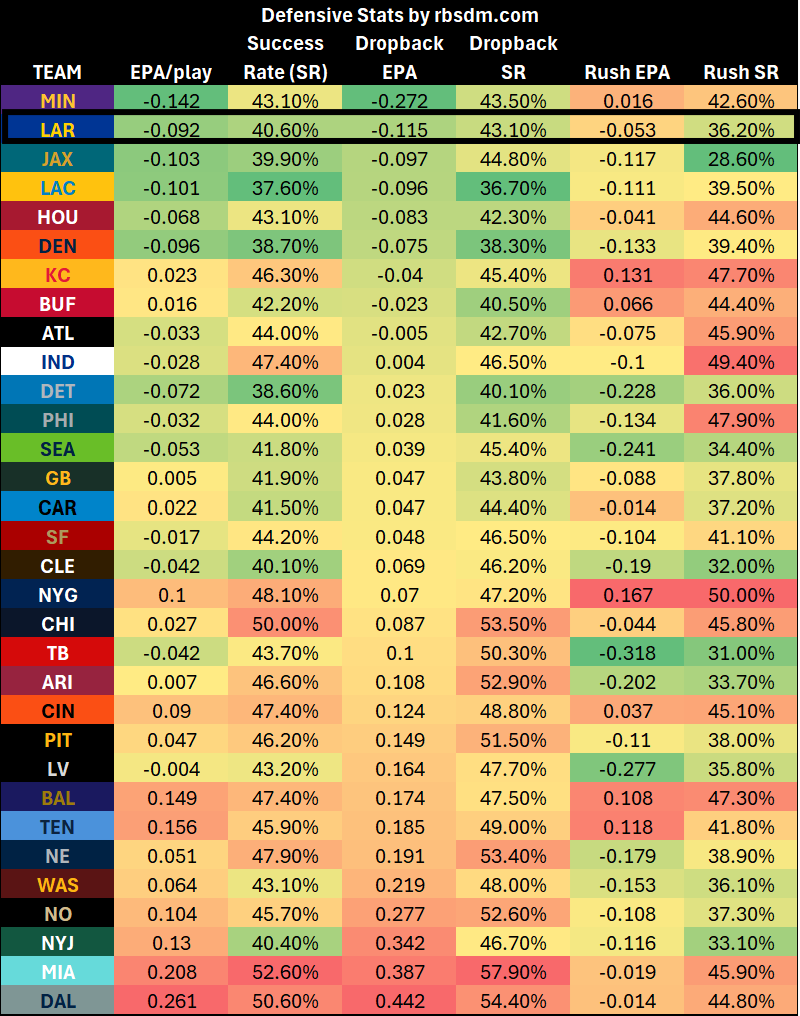
This poses a difficult matchup in general, of course. And the Rams are a bit of a run funnel, as they only rank 26th in defensive rush EPA.
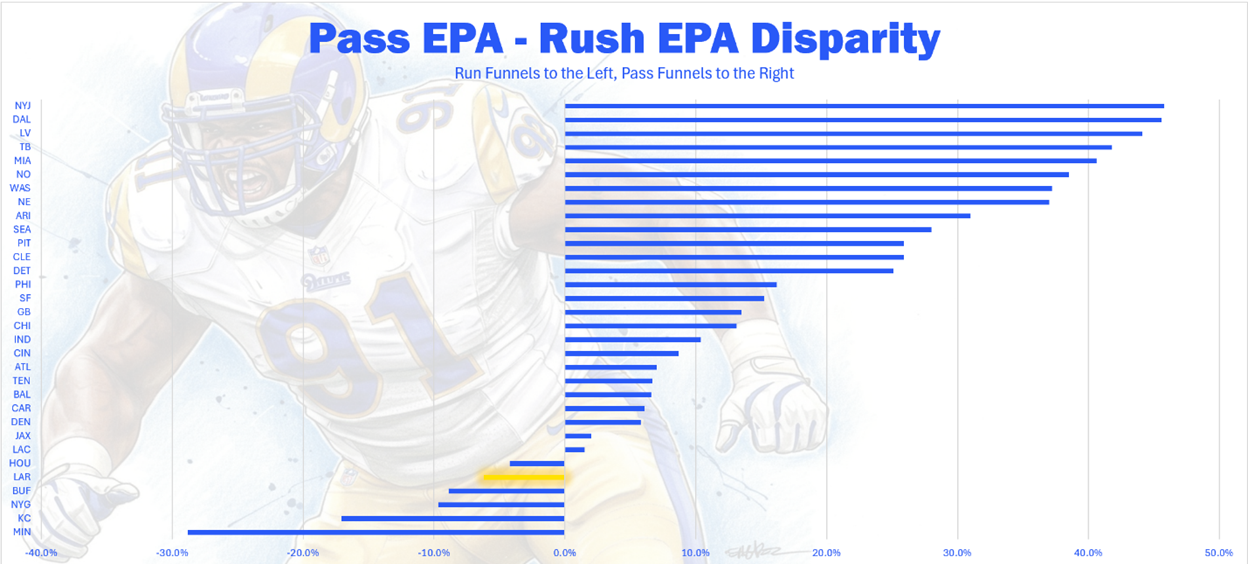
Moreover, the Niners don’t have much firepower with their three best WRs and star TE all out. This is likely to lead them to run their entire offense through McCaffrey. This makes sense because McCaffrey is up to his old tricks, leading all RBs in PPR and expected points per game (EP/G). McCaffrey has been the overall RB1 a remarkable three times; the only RB who has ever been the RB1 more times than McCaffrey since 1990 is Emmitt Smith.
This doesn’t actually assume that McCaffrey will lead them to the promised land on the ground; with the Rams playing poorly in rush defense, it may be tempting to try. However, despite McCaffrey's outstanding performance this season, he has not been stellar strictly as a rusher. Despite ranking sixth in attempts (69), McCaffrey ranks 23rd in rushing yards (225), only earning -2.1 EPA added (40th) and -0.99 rush yards over expected (RYOE, 40th).
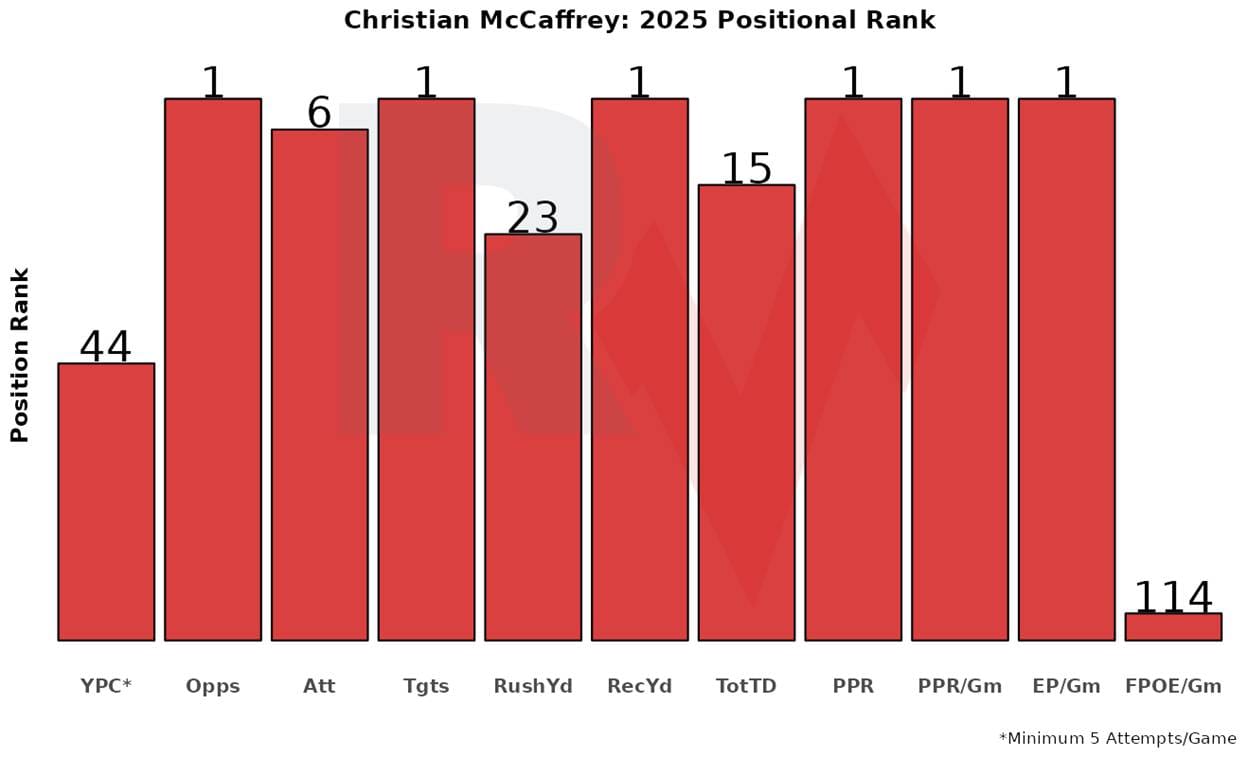
But McCaffrey is by far the most targeted RB in football (40), earning 14 more than second-place De’Von Achane (26). If McCaffrey were compared alongside WRs, he would still rank third in targets based on PFF data behind only Puka Nacua (46) and Chris Olave (41), and his 29% target share would be tied for seventh, according to RotoViz data.
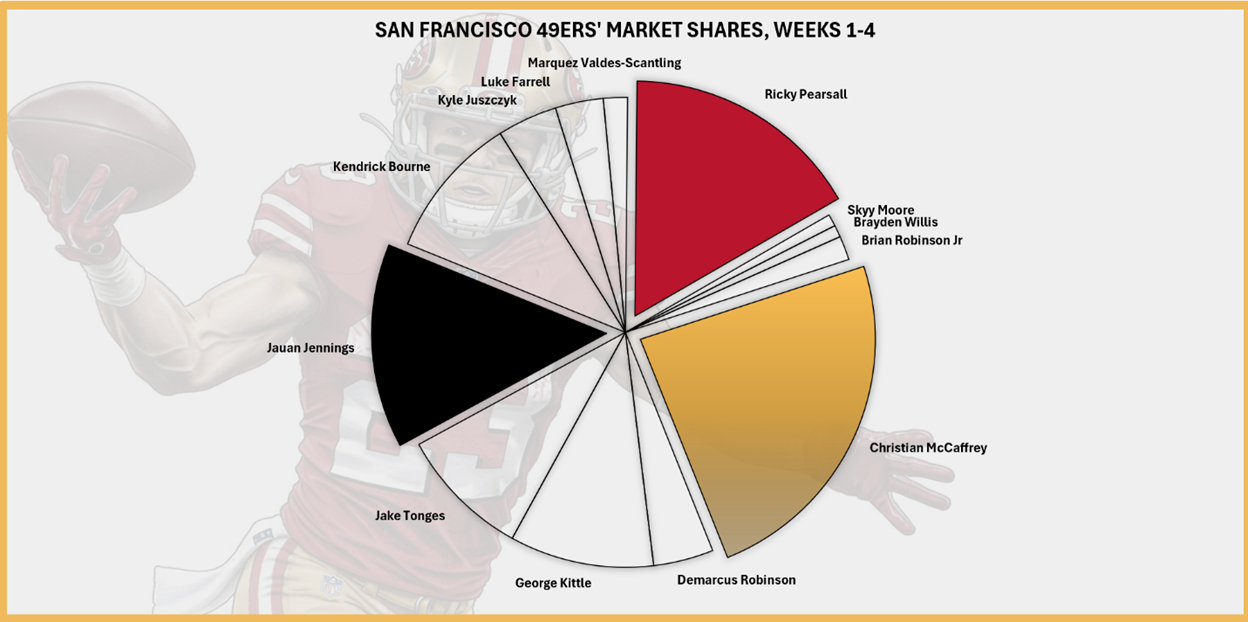
The Rams have been defensively stellar dating back to last year; they have allowed the fewest PPR points to RBs over their last five regular-season games, ranking 31st in defensive EP allowed to RBs and 30th in defensive fantasy points over expected (FPOE) against RBs.
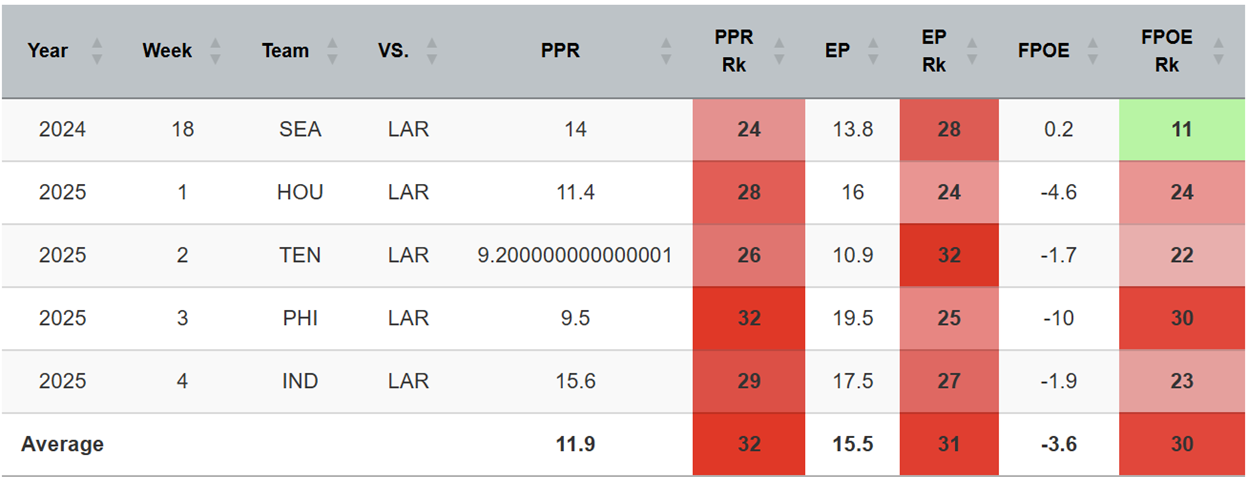
They are similarly stingy against specifically RB pass-catching, allowing the fewest receptions and second-fewest receiving yards to RBs in their last five games as well.
This becomes an immovable object/unstoppable force situation, as McCaffrey ranks high among RBs in almost every meaningful receiving metric, including air yards share (1st), yards after catch (YAC, 3rd), receiving yards after contact (YACO, 3rd), first-read targets (1st), first downs (1st), receiving forced missed tackles (MFT, 2nd), designed receptions (1st), and Fantasy Points’ expected fantasy points (XFP, 1st).
But also, McCaffrey has struggled with the types and rates of coverage the Rams have employed this season. Against Cover 3, McCaffrey has scored only 0.14 fantasy points per route run (FP/RR, 26th). Historically, Cover 3 is not necessarily a challenging defense for RB receiving production, but this assumes RBs are settling for check-downs, and that isn’t necessarily who McCaffrey is.
McCaffrey does run the most backfield routes in the NFL (94), but he only runs backfield routes 75.2% of the time he goes out for a pass, which is 42nd among RBs with at least 25 backfield routes. He runs 12.8% with horizontal breaks (16). The next closest RB in horizontally-breaking routes is Bijan Robinson with 10 (9.3%), and McCaffrey is only one of five RBs with at least five horizontally-breaking routes through the first four games. On these routes, McCaffrey’s 38% targets per route run (TPRR) compares favorably to his 33% TPRR on all routes, and his 18.8% win rate smashes his 3.2% win rate, which, alone, ranks seventh among RBs.
McCaffrey also runs 18% of his routes from the slot, trailing only Zavier Scott (21.6%) and Achane (21.3%) among RBs with at least 25 total routes. This gives him 27 slot routes total (1st), 12 more than Achane. From such routes, McCaffrey has an 11.1% separation score (2nd), again outpaces his normal TPRR with 37%, and far outpaces his normal win rate at 14.8%.
If McCaffrey were a WR, he would rank second in target share (37%) and targets per route run (37%) in routes from the slot, behind only Nacua in each category. Including WRs, he would rank fifth in FP/RR from the slot (0.64), behind only Courtland Sutton, Amon-Ra St. Brown, Nacua, and Quentin Johnston.
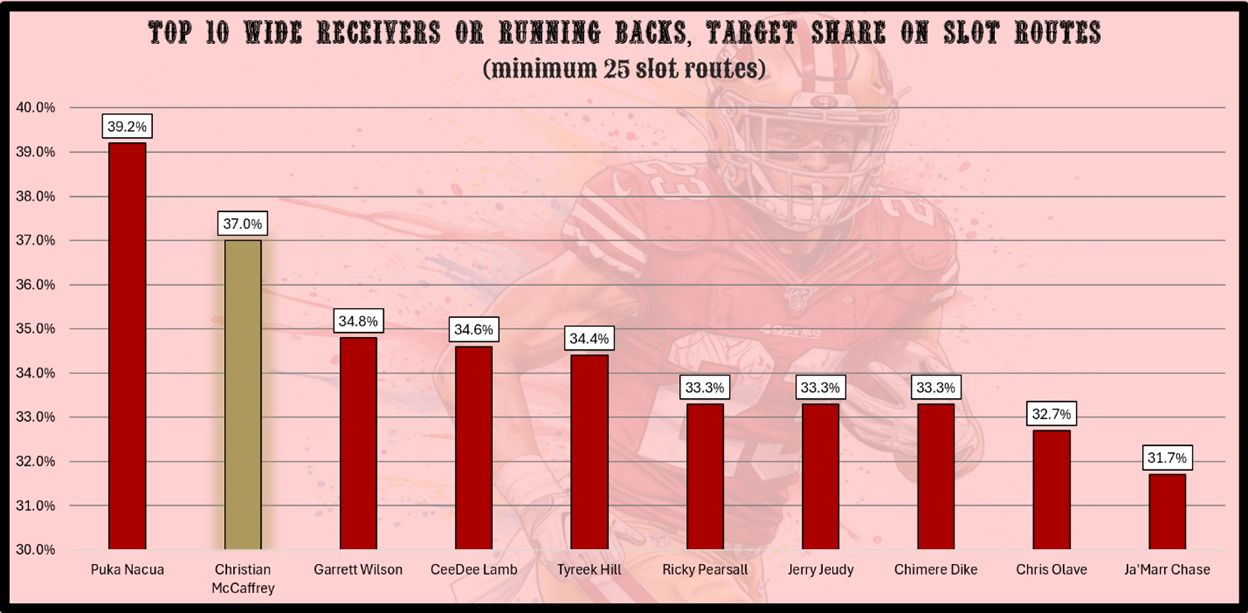
Contrary to the Rams’ strict defense against pass-catching RBs in general, they have surrendered a slot target share of 39.0% (31st), so this could drastically change the math if the 49ers choose to place McCaffrey in the slot just as they have (if not more). It is also worth noting that, despite a poor FP/RR on routes against Cover 3, McCaffrey has already run his most significant percentage of routes against Cover 3 (25.6%). Yet, he’s still in a good position, remaining the top fantasy performer thanks to his incredible receiving production.
The bottom line, of course, is that we aren’t sitting the top RB in managed leagues; in daily formats, there is hope he can still be a good play, but it hinges on the offense definitively filtering through McCaffrey, even though it plays into the defense’s strengths, and even though the Rams will undoubtedly key on McCaffrey as much as possible.
The 49ers’ projected receiving core would be WR DeMarcus Robinson, WR Kendrick Bourne, WR Skyy Moore, and TE Jake Tonges. Against the Rams, PFF’s Matchup Tool has Tonges’ personnel matchup as the best, grading out as good. Robinson’s personnel matchup is fair, and the other two WRs’ matchups are poor.
Tonges also grades out with a +26.5% coverage grade against the types and rates of coverage the Rams run based on Fantasy Points' Coverage Grade; the others are a mystery, as they don’t have enough route data as 49ers.
The reality is that, while tempting to chase the contrarian start on any of these players, it’s a bit of a dart throw. Tonges seems to be the safest option; it might be a stretch to say we can trust him, but he’s clearly ahead of the others. The other pass-catchers can’t be seen as highly dependable (aside from McCaffrey), particularly with an injured backup QB and a low implied team total.
The 49ers’ matchups up front are relatively neutral, as there is neither a significant advantage nor disadvantage for the O-line in either pass-blocking or run-blocking, and this is one area where the team is relatively healthy. This doesn’t strike me as an important factor.
